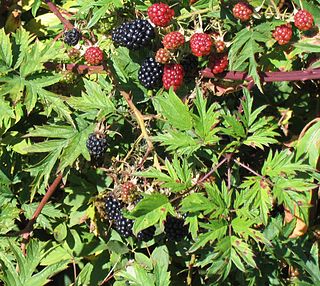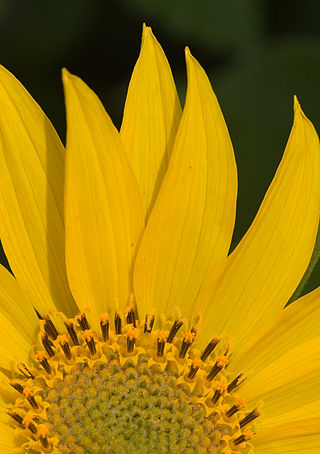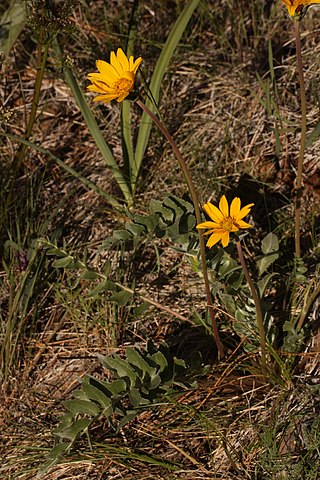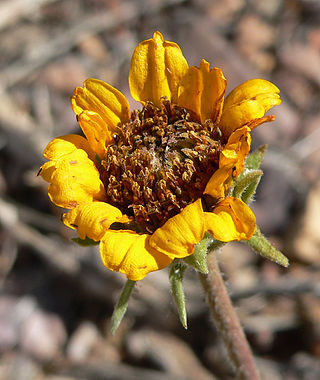
Rubus laciniatus, the cutleaf evergreen blackberry or evergreen blackberry, is a species of Rubus, native to Eurasia. It is an introduced species in Australia and North America. It has become a weed and invasive species in forested habitats in the United States and Canada, particularly in the Northeast and along the Pacific Coast.

Balsamorhiza is a genus of plants in the family Asteraceae known commonly as balsamroots. These are perennials with fleshy taproots and caudices bearing erect stems and large, basal leaves. Atop the tall stems are showy yellow sunflower-like blooms. Balsamroots are native to western North America.

Encelia virginensis is a North American species of flowering plants in the family Asteraceae known by the common name Virgin River brittlebush. This shrub is native to the southwestern United States and northwestern Mexico, particularly the Mojave Desert and the Sonoran Desert. It has been found in Baja California, southern California, Nevada, Arizona, southwestern Utah, and southwestern New Mexico.

Gaillardia aristata is a North American species of flowering plant in the sunflower family, known by the common names common blanketflower and common gaillardia. This perennial wildflower is widespread across much of North America, from Yukon east to Québec and south as far as California, Arizona, Illinois, and Connecticut, although it may be naturalized rather than native in parts of that range. It is also naturalized in scattered locations in Europe, Australia, and South America.

Ageratina herbacea is a North American species of flowering plants in the family Asteraceae known by the common names fragrant snakeroot and Apache snakeroot. It is native to desert regions of the southwestern United States and northern Mexico. It grows in rocky slopes in conifer forests and woodlands.

Balsamorhiza deltoidea is a species of flowering plant in the sunflower tribe of the plant family Asteraceae known by the common name deltoid balsamroot. It is native to western North America from British Columbia to California, where it grows in many types of generally mountainous habitat.

Balsamorhiza macrolepis is a species of flowering plant in the tribe Heliantheae of the family Asteraceae, known by the common name California balsamroot. It is found only in California, where it grows in dry, open habitat, mostly in mountainous areas, mostly in the western foothills of the Sierra Nevada and in the eastern Coast Ranges near San Francisco Bay. It is now becoming rare in the Coast Ranges.

Balsamorhiza sagittata is a North American species of flowering plant in the tribe Heliantheae of the family Asteraceae known by the common name arrowleaf balsamroot. Also sometimes called Oregon sunflower, it is widespread across western Canada and much of the western United States.

Balsamorhiza sericea is a species of flowering plant in the tribe Heliantheae of the family Asteraceae known by the common name silky balsamroot. It is native to the Klamath Mountains of northwestern California and southwestern Oregon, with additional populations in the Blue and Steens Mountains in eastern Oregon. It grows in rocky areas, sometimes on serpentine soils.

Calycadenia multiglandulosa is a species of flowering plant in the family Asteraceae, known by the common names sticky calycadenia and sticky western rosinweed. It is endemic to California, where it is a common in the Coast Ranges and in the Sierra Nevada Foothills from Shasta County to Kern County.

Crepis modocensis is a species of flowering plant in the family Asteraceae known by the common name Modoc hawksbeard.

Balsamorhiza hookeri is a North American species of perennial plant in the family Asteraceae. It grows in the Great Basin and neighboring regions in the Western United States. It is found in Washington, Oregon, California, Idaho, Nevada, Utah, and Arizona.

Balsamorhiza hispidula is a North American species of plants in the sunflower tribe within the aster family. It is native to western United States, primarily the Great Basin and other dry, relatively flat terrain. It has been found in Idaho, Montana, Wyoming, Oregon, Nevada, Colorado, Utah, and Arizona.

Balsamorhiza incana is a North American species of plants in the tribe Heliantheae of the family Asteraceae. It is native to the northwestern United States, in Idaho, Montana, Wyoming, Washington, and Oregon.
Balsamorhiza rosea is a North American species of plants in the sunflower tribe within the aster family. It is native to the northwestern United States, in Washington and Oregon.

Balsamorhiza lanata, with the common name lanate balsamroot, is a species of plant in the tribe Heliantheae of the family Asteraceae native to California.

Centromadia pungens, the common spikeweed or common tarweed, is a species of North American plants in the tribe Madieae within the family Asteraceae. It is native to northern Baja California and the western United States. The plant is considered a noxious weed in parts of the Pacific Northwest.

Centromadia parryi, the pappose tarweed, is a species of plant in the tribe Madieae within the family Asteraceae. It is found in North America where it is native to California and, northern Baja California.

Deinandra kelloggii, Kellogg's spikeweed or Kellogg's tarweed, is a North American species of plant in the tribe Madieae within the family Asteraceae. It is native to Baja California, southern and central California, and Arizona.

Ericameria parishii, or Parish's rabbitbrush, is a western North American species of flowering plants in the family Asteraceae.



















